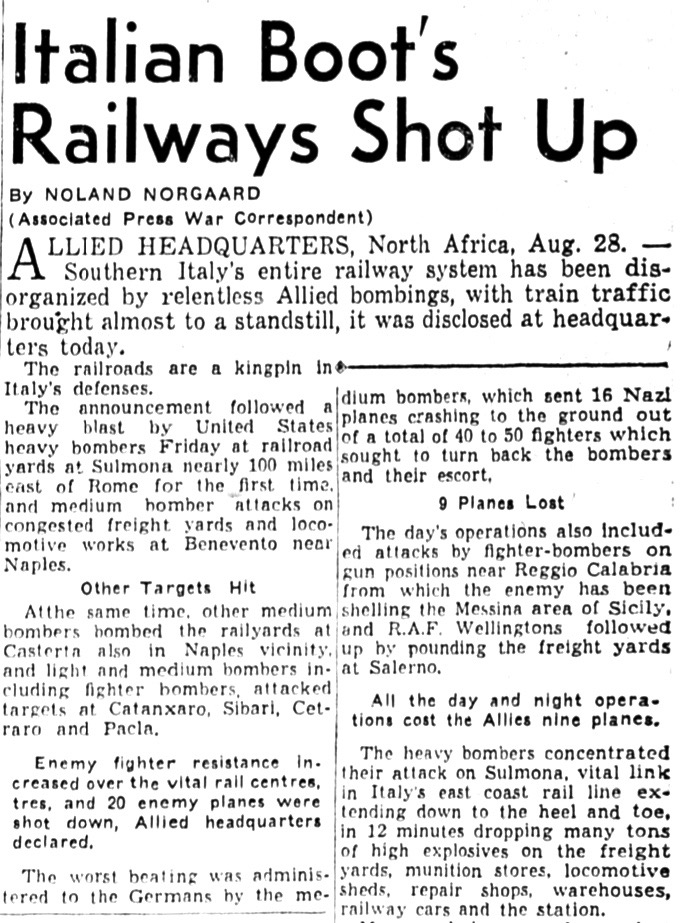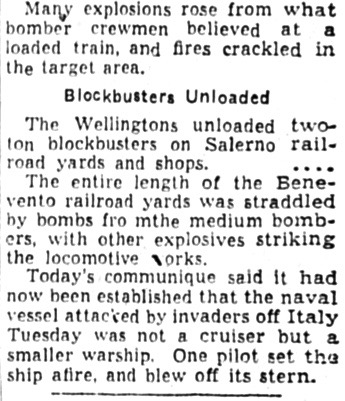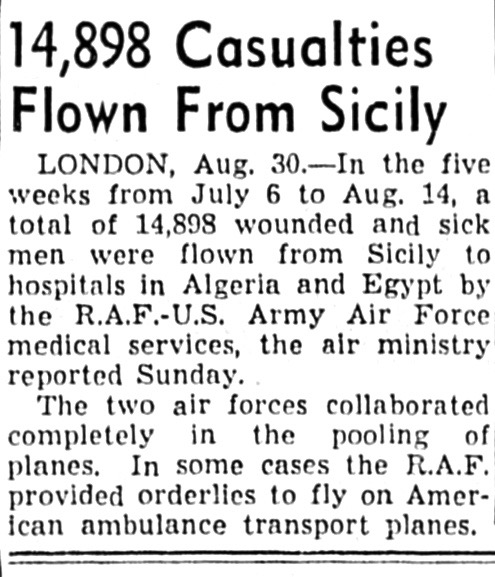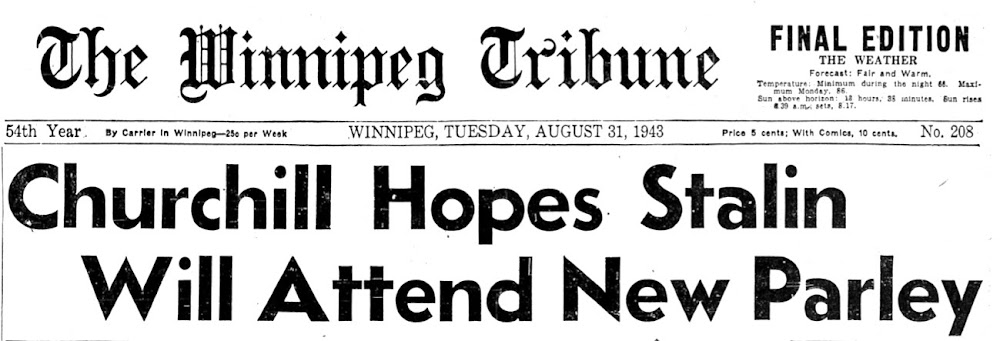The Invasion of the Toe of Italy's Boot, Beginning Sept. 3, 1943
Articles, Context from The Winnipeg Tribune, Aug. 28 - 31, '43
It's official. The countdown has begun. 10, 9, 8, 7...
When news from Saturday, August 28, 1943 ("Raid on Nuremburg, Churchill Flicks Cigar Butt over Niagara Falls, Italy's Boot is Polished," etc.) hit street corners in Winnipeg and other cities, towns and villages across Central Canada, the invasion of Italy at Reggio di Calabria - unbeknownst to readers and 95% of the armed forces - was a mere seven days away.
Monty's Eighth Army, accompanied by the Canadian Army, were settled in Sicilian ports and beachside communities along that island's north-eastern coast. They rested and geared up for their attack. Little did the Canadians know, but some of the troops would travel in Canadian landing crafts (80th Flotilla) for the first time during the war.
Allied naval forces, including huge warships and small but fleet-footed assault craft, set guns sights on the toe of the boot and jockeyed for safe positions near the beach, respectively.
For the Canadians in Combined Operations (including my father Doug Harrison), with about a dozen Landing Craft, Mechanised (LCMs) ready for service, engines finely-tuned, ramps and winches greased and oiled, some rare moments of spare time were likely spent looking for the basics of life in a strange land. If they had learned anything during their 4 - 5 week-long stint in Sicily during its invasion (Operation Husky, beginning July 10, about two months earlier), they would get their assigned tasks done very well (and earn Monty's admiration and praise again), but would very likely have to fend for themselves for food, drink, clothing, accommodation, and any other necessities of life.
So, while readers turned the pages of The Tribune (see below : ), our sailors were looking for accommodation better than the cattle caves they'd lived in, south of Syracusa, several weeks back.
News from Saturday's Tribune:
Bomber Command:
"After we flatten Nuremberg we should blast Italy's shin at Naples and Salerno to make Operation Avalanche a bit easier." (I.e., invasion of Italy by U.S. Fifth Army, Sept. 9)
"Yes, but let's not forget the boot. Operation Baytown is next."
Bomber Command in North Africa did pay attention to the Salerno and Reggio areas in order to soften defences before subsequent assaults of the Italian mainland. We will soon learn that Monty's Eighth ( w Canadian forces) had an easier time at the toe (Reggio and area) than Clark's Fifth at the shin (Salerno). Axis defences were almost non-existent on September 3, but very stiff and hostile on the 9th.
For the men of the barges ("Don't call 'em barges," I have read), including my father, "Sicily was hot, Italy was easy"* - and they were not referring to the weather. When a few sailors wrote memoirs re Operation Husky they almost all mention the constant bombing and strafing they had to endure from the German Luftwaffe during the first three days, beginning July 10.
[*Click here to read news that mentions the landings at Sicily and Italy]
If we go back to one particular, very-well-written navy memoir, we can learn not only about the bombings and strafings but 'lessons learned' by Canadian sailors who had to fend for themselves in an always-risky war zone.
Clayton Marks (RCNVR, Combined Operations; from London, Ontario) writes the following account - extensive, and rare - about the early days in Sicily:
Following the assault convoys* and moving into station off the beaches even before the first arrivals withdrew, came ships with the heavier mechanized equipment and supplies for depots to be established inland. Vessels carrying the larger landing craft came with them, and two of these carried the 80th and 81st Canadian LCM Flotillas which were to land near Avola. The LCM's began their work four hours after the LCA's but instead of finishing in twelve hours, they were to be occupied for some ten weeks, first on Sicily and then on the Italian mainland.
[*assault convoys included two Canadian Landing Craft Assault Flotillas (LCAs), the 55th and 61st]
The first of the LCM's (Landing Craft, Mechanised) were lowered from their parent ships at about five-thirty on the morning of the assault, a few minutes before sunrise*. Loaded with vehicles and stores, they steered in toward beaches now securely held, deposited their freight, and turned back for more. For the first few hours there was no interruption to the ordered chaos of the build-up. Transports stood off the coast, each with its identification number placarded on its side. Landing craft ran in under their high sides, loaded with feverish haste and put off to unload at the same tempo ashore, satisfying the most urgent of the hand-to-mouth requirements.
[*Between the sending of the LCAs and LCMs, my father found time to fish from the side of his transport ship]
At one point gasoline would be required to get vehicles moving inland; at another troops would be running short of ammunition. Headquarters units would require more signalling equipment; troops held up by resistance on the forward fringes might need a howitzer to break through. The landing craft was diverted from ship to ship and from point to point along the beaches* to meet each need as it developed. This was the preliminary phase of the work, preceding the stage when shore depots would be established and stored; and it had to be got over with in a hurry before enemy aircraft arrived.
[*The Canadians that manned landing crafts were assigned to JIG, HOW, and GEORGE Beaches, depending on "each need". See map below.]
Photo Credit - Location of Eighth Army Landings
C. Marks continues:
The comparative quiet was broken at nine o'clock in the morning. An enemy bomber came in very fast and dropped a stick of bombs along a stretch of shoreline occupied by two British vessels and by the Canadian landing craft carrying the Senior Officer of the 80th Flotilla. The smaller British vessel, a tank landing craft, was squarely hit and blown to pieces. The other British ship was heavily damaged, and every man on her bridge was killed. The Canadian craft, well up on the beach with some of her men ashore nearby, had a miraculous escape. The force of the explosions knocked down the men on the beach, and the Flotilla Officer was blown back into the well deck of his ship, but no one was injured. Considerably dazed, but marveling at their luck, the men recovered and went to the assistance of the British merchantman, helping to take off her wounded and transfer them to a hospital ship.
Two hours later a series of heavier raids began. Throughout the night and for the next forty-eight hours the attempted blitz rose to a total of twenty-three separate raids, costing the invasion forces five merchantmen and a hospital ship. The decline of the Luftwaffe's efforts was rapid, however. Air cover from Malta began to show its murderous effectiveness, and by the third day planes flying from captured Sicilian bases were adding their strength to the Allied umbrella.
During the four weeks that followed, the work of landing stores and reinforcements settled down into a routine for the craft of the 80th and 81st Flotillas. It was a grinding routine, and it was never free from danger. Every type of cargo had to come ashore in their craft; sixteen-ton tanks, heavy trucks, tiers of cans of high-octane gasoline, ammunition, army rations, small arms and mortars. Heavy seas often made both the run-ins and the work of loading and unloading very difficult. The huge requirements of the armies put heavy pressure on the ferry system and for the first forty-eight hours of the operation every man remained on the job without rest. Even after that, the best arrangement that could be worked out was a routine of forty-eight hours on for twenty-four hours off.
The Canadian Flotillas formed, of course, only a small part of all the Flotillas engaged, but wherever they operated the warmly admiring comments of British Officers seemed to indicate that they were pace-setters. The mechanical aptitude and the loving care which their maintenance parties lavished on the craft gave particular cause to marvel. During eighteen days of continuous work not one craft of the Flotilla was out of operation.
The demands of the armies proved higher and the demolitions in Sicilian harbours more inconvenient than had been expected, and landing craft had therefore to be kept longer on the ferry service. This meant a great deal of discomfort for the Canadians, as for all the landing craft Flotillas. The beaches of semi-tropical Sicily in late July and early August were far from being health resorts. Almost every man suffered at one time or another from a variety of disorders which included dysentery, septic scratches, jaundice, sandfly and malarial fever.
The small, amphibious craft were not equipped for life on the beaches. Moreover, their men were now everybody's children and no one's. Their parent landing ships had long since departed. They ferried cargo ashore from every ship that came, but their home was the hot beach, and there their companies had to make what living arrangements they could.
Some found accommodation of a sort in an old, disused Army camp and many more had to take shelter in a very dirty and uncomfortable cattle cave. Their food consisted of rations acquired from the Army, occasional largesse scrounged from the better-hearted merchant ships, and what they could acquire from an impoverished countryside.
The cave-dwelling members of the Flotilla had improvised a stove of petrol tins in order to apply some heat to their unsavoury victuals; and one evening the stove blew up. Flames licked back into the cave, igniting another can of petrol and consuming most of the kit bags, hammocks and clothing of the men. About half the personnel of the 80th Flotilla had to get along for the next three months on borrowed gear.
The cave-dwelling members of the Flotilla had improvised a stove of petrol tins in order to apply some heat to their unsavoury victuals; and one evening the stove blew up. Flames licked back into the cave, igniting another can of petrol and consuming most of the kit bags, hammocks and clothing of the men. About half the personnel of the 80th Flotilla had to get along for the next three months on borrowed gear.
Pages 83 - 85, from Combined Operations
During the invasion of Sicily, four Canadian flotillas of landing craft took part, and two of them (the 80th and 81st) stayed in action for about four weeks. The upcoming action in Italy (the actual starting date was not known to the sailors) was soon to unfold. Their role would change to a degree, as would their daily routine, along with their access to food, clothing and shelter. More details from authentic memoirs about the early days of the invasion of Italy will follow.
And now. back to The Winnipeg Tribune:
"Always carry a carrot. Mules are balkier than landing crafts."
Meanwhile, back in Canada (while Canadian sailors in the Med are scrambling for the basics of life), the hot dog bun is scratched off the menu:
The next brief report caught my eye because the "origin story" re how Canadian members of RCNVR got involved with Combined Operations (C.O.) back in Halifax in November, 1941, is perhaps connected to a young recruit who thought signing up for C.O. meant he would be put in charge of an MTB (motor torpedo boat).
"A complete lack of defensive action around the Strait of Messina" would have been good news to the members of the 80th Flotilla.
But, did The Trib deliver to The Med?
Note - the article was longer, but not re the Calabrian coast.
Research note: News reels would be a great source of information re Canadian forces in Sicily. And FOX MOVIETONE NEWS is accessible online. Happy hunting, I say!
The day of the invasion draws nearer, and if German leaders had access to The Tribune they would get a pretty good idea of where a good landing spot might be:
Many of us have heard the joke about an American asking for a bit of help when coming to visit a friend in Canada for the first time.
The visitor crosses the border and asks the first Canadian he sees a simple question: "Do you know where Fred Johnson lives?"
The following news clip might be part of that joke's "origin story":
Are Canadian Paramount News reels available online? Happy hunting?
Alan Randal, another fine Canadian war correspondent, keeps readers well informed:
In conclusion, I end this post with a real cliff hanger. Where are those three German escapees?!
More news from The Tribune and memoirs from Canadians in Combined Ops will soon follow.
Please link to Editor's Research: Operation Baytown (Italy WWII) (1).
Unattributed Photos GH





























No comments:
Post a Comment